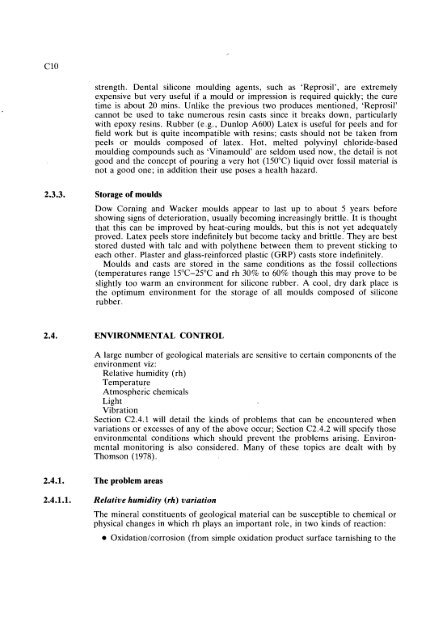GUIDELINES FOR THE CURATION OF GEOLOGICAL MATERIALS
GUIDELINES FOR THE CURATION OF GEOLOGICAL MATERIALS
GUIDELINES FOR THE CURATION OF GEOLOGICAL MATERIALS
You also want an ePaper? Increase the reach of your titles
YUMPU automatically turns print PDFs into web optimized ePapers that Google loves.
strength. Dental silicone moulding agents, such as 'Reprosil', are extremely<br />
expensive but very useful if a mould or impression is required quickly; the cure<br />
time is about 20 mins. Unlike the previous two produces mentioned, 'Reprosil'<br />
cannot be used to take numerous resin casts since it breaks down, particularly<br />
with epoxy resins. Rubber (e.g., Dunlop A600) Latex is useful for peels and for<br />
field work but is quite incompatible with resins; casts should not be taken from<br />
peels or moulds composed of latex. Hot, melted polyvinyl chloride-based<br />
moulding compounds such as 'Vinamould' are seldom used now, the detail is not<br />
good and the concept of pouring a very hot (150°C) liquid over fossil material is<br />
not a good one; in addition their use poses a health hazard.<br />
2.3.3. Storage of moulds<br />
Dow Corning and Wacker moulds appear to last up to about 5 years before<br />
showing signs of deterioration, usually becoming increasingly brittle. It is thoughi<br />
that this can be improved by heat-curing moulds, but this is not yet adequately<br />
proved. Latex peels store indefinitely but become tacky and brittle. They are best<br />
stored dusted with talc and with polythene between them to prevent sticking to<br />
each other. Plaster and glass-reinforced plastic (GRP) casts store indefinitely.<br />
Moulds and casts are stored in the same conditions as the fossil collections<br />
(temperatures range 15"C-25"C and rh 30% to 60% though this may prove to be<br />
slightly too warm an environment for silicone rubber. A cool, dry dark place 1s<br />
the optimum environment for the storage of all moulds composed of silicone<br />
rubber.<br />
ENVIRONMENTAL CONTROL<br />
A large number of geological materials are sensitive to certain components of the<br />
environment viz:<br />
Relative humidity (rh)<br />
Temperature<br />
Atmospheric chemicals<br />
Light<br />
Vibration<br />
Section C2.4.1 will detail the kinds of problems that can be encountered when<br />
variations or excesses of any of the above occur; Section C2.4.2 will specify those<br />
environmental conditions which should prevent the problems arising. Environmental<br />
monitoring is also considered. Many of these topics are dealt with by<br />
Thomson (1978).<br />
2.4.1. The problem areas<br />
2.4.1.1. Relative humidity (rh) variation<br />
The mineral constituents of geological material can be susceptible to chemical or<br />
physical changes in which rh plays an important role, in two kinds of reaction:<br />
Oxidation/corrosion (from simple oxidation product surface tarnishing to the

















